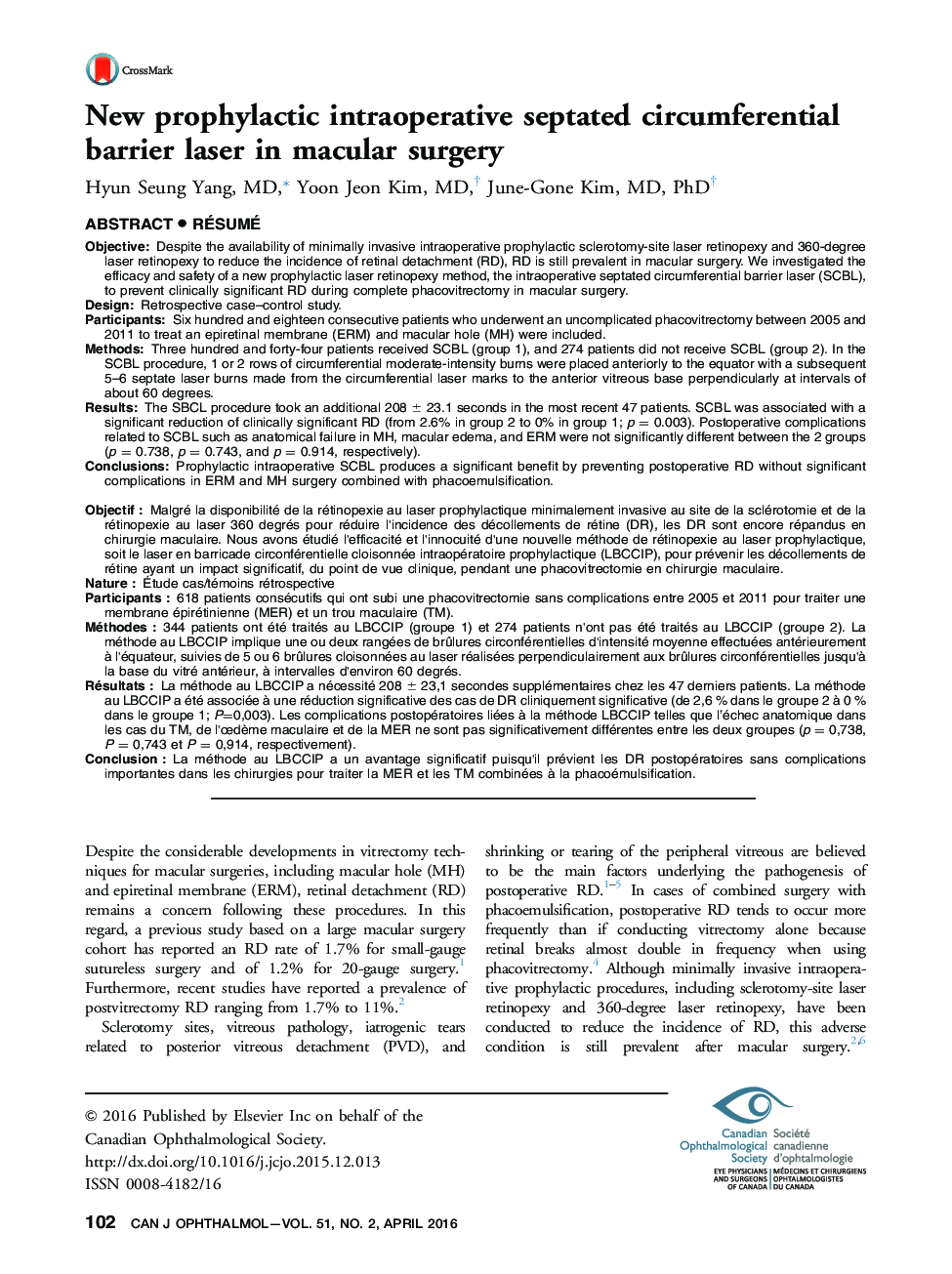| کد مقاله | کد نشریه | سال انتشار | مقاله انگلیسی | نسخه تمام متن |
|---|---|---|---|---|
| 4008924 | 1602391 | 2016 | 6 صفحه PDF | دانلود رایگان |
ObjectiveDespite the availability of minimally invasive intraoperative prophylactic sclerotomy-site laser retinopexy and 360-degree laser retinopexy to reduce the incidence of retinal detachment (RD), RD is still prevalent in macular surgery. We investigated the efficacy and safety of a new prophylactic laser retinopexy method, the intraoperative septated circumferential barrier laser (SCBL), to prevent clinically significant RD during complete phacovitrectomy in macular surgery.DesignRetrospective case–control study.ParticipantsSix hundred and eighteen consecutive patients who underwent an uncomplicated phacovitrectomy between 2005 and 2011 to treat an epiretinal membrane (ERM) and macular hole (MH) were included.MethodsThree hundred and forty-four patients received SCBL (group 1), and 274 patients did not receive SCBL (group 2). In the SCBL procedure, 1 or 2 rows of circumferential moderate-intensity burns were placed anteriorly to the equator with a subsequent 5–6 septate laser burns made from the circumferential laser marks to the anterior vitreous base perpendicularly at intervals of about 60 degrees.ResultsThe SBCL procedure took an additional 208 ± 23.1 seconds in the most recent 47 patients. SCBL was associated with a significant reduction of clinically significant RD (from 2.6% in group 2 to 0% in group 1; p = 0.003). Postoperative complications related to SCBL such as anatomical failure in MH, macular edema, and ERM were not significantly different between the 2 groups (p = 0.738, p = 0.743, and p = 0.914, respectively).ConclusionsProphylactic intraoperative SCBL produces a significant benefit by preventing postoperative RD without significant complications in ERM and MH surgery combined with phacoemulsification.
RésuméObjectifMalgré la disponibilité de la rétinopexie au laser prophylactique minimalement invasive au site de la sclérotomie et de la rétinopexie au laser 360 degrés pour réduire l'incidence des décollements de rétine (DR), les DR sont encore répandus en chirurgie maculaire. Nous avons étudié l'efficacité et l'innocuité d'une nouvelle méthode de rétinopexie au laser prophylactique, soit le laser en barricade circonférentielle cloisonnée intraopératoire prophylactique (LBCCIP), pour prévenir les décollements de rétine ayant un impact significatif, du point de vue clinique, pendant une phacovitrectomie en chirurgie maculaire.NatureÉtude cas/témoins rétrospectiveParticipants618 patients consécutifs qui ont subi une phacovitrectomie sans complications entre 2005 et 2011 pour traiter une membrane épirétinienne (MER) et un trou maculaire (TM).Méthodes344 patients ont été traités au LBCCIP (groupe 1) et 274 patients n'ont pas été traités au LBCCIP (groupe 2). La méthode au LBCCIP implique une ou deux rangées de brûlures circonférentielles d'intensité moyenne effectuées antérieurement à l'équateur, suivies de 5 ou 6 brûlures cloisonnées au laser réalisées perpendiculairement aux brûlures circonférentielles jusqu'à la base du vitré antérieur, à intervalles d'environ 60 degrés.RésultatsLa méthode au LBCCIP a nécessité 208 ± 23,1 secondes supplémentaires chez les 47 derniers patients. La méthode au LBCCIP a été associée à une réduction significative des cas de DR cliniquement significative (de 2,6 % dans le groupe 2 à 0 % dans le groupe 1; P=0,003). Les complications postopératoires liées à la méthode LBCCIP telles que l’échec anatomique dans les cas du TM, de l'œdème maculaire et de la MER ne sont pas significativement différentes entre les deux groupes (p = 0,738, P = 0,743 et P = 0,914, respectivement).ConclusionLa méthode au LBCCIP a un avantage significatif puisqu'il prévient les DR postopératoires sans complications importantes dans les chirurgies pour traiter la MER et les TM combinées à la phacoémulsification.
Journal: Canadian Journal of Ophthalmology / Journal Canadien d'Ophtalmologie - Volume 51, Issue 2, April 2016, Pages 102–107
